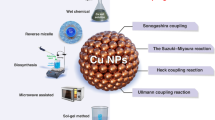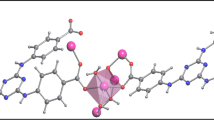Abstract
Three new molecular compounds, [Ni5(bta)6(CO)4], I, [Ni9(bta)12(CO)6], II, [Ni9(bta)12(CO)6]. 2(C3H7NO), III, (bta = benzotriazole) were prepared employing solvothermal reactions. Of these, I have pentanuclear nickel, whereas II and III have nonanuclear nickel species. The structures are formed by the connectivity between the nickel and benzotriazole giving rise to the 5- and 9-membered nickel clusters. The structures are stabilised by extensive π…π and C-H... π interactions. Compound II and III are solvotamorphs as they have the same 9-membered nickel clusters and have different solvent molecules. To the best of our knowledge, the compounds I–III represent the first examples of the same transition element existing in two distinct coordination environment in this class of compounds. The studies reveal that compound I is reactive and could be an intermediate in the preparation of II and III. Thermal studies indicate that the compounds are stable upto 350∘C and at higher temperatures (∼ 800∘C) the compounds decompose into NiO. Magnetic studies reveal that II is anti-ferromagnetic.

Nickel carbonyl compounds containing five and nine nickel centers have been synthesized and structurally characterized. Pentamer nickel compound transforms to the nonamer compounds as a function of time and temperature.








Similar content being viewed by others
References
(a) Special issue on MOF: 2012 Chem. Rev. 112 673; (b) Special issue on MOF: 2009 Chem. Soc. Rev. 38 1213; (c) Special issue on MOF: 2010 Eur. J. Inorg. Chem. 3683; (d) Kitagawa S, Kitaura R and Noro S-I 2004 Angew Chem Int. Ed. 43 2334
(a) Bajpe S R, Breynaert E, Mustafa D, Jobbágy M, Maes A, Martens J A and Kirschhock C E A 2011 J. Mater. Chem. 21 9768; (b) Coronado E, Gómez-García C J 1998 Chem. Rev. 98 273; (c) López X, Carbó J J, Carles Bo and Poblet J M 2012 Chem. Soc. Rev. 41 7537
(a) Rosnes M H, Yvon C, Long D-L and Cronin L 2012 Dalton Trans. 41 10071; (b) Song Y-F, Long D-L, Kelly S E and Cronin L 2008 Inorg. Chem. 47 9137; (c) Hu Y, An H, Liu H, Yin J, Wang H, Zhang H and Wang L 2014 Dalton Trans. 43 2488
Chakrabarti S and Natarajan S 2002 Cryst. Growth Des. 2 333
(a) Pope M T 1983 In Heteropoly and Isopoly Oxometalate (New York: Springer Verlag); (b) Pope M T and Müller 1991 Angew Chem. Int. Ed. Engl. 30 34
(a) Caneschi A, Gatteschi D and Sessoli R 1991 J. Am. Chem. Soc. 113 5874; (b) Sessoli R, Tsai H L, Schake A R, Wang K S, Vincent B, Folting K, Gatteschi D, Christou G and Hendrickson D N 1993 J. Am. Chem. Soc. 115 1804
(a) Long D-L, Burkholder E, Cronin L 2007 Chem. Soc. Rev. 36 105; (b) Song Y F, Long D-L and Cronin L 2007 Angew Chem. Int. Ed. 46 3900; (c) Winter R S, Yan J, Busche C, Mathieson J S, Prescimone A, Brechin E K, Long D-L and Cronin L 2013 Chem. Eur. J. 19 2976
(a) Sheikh J A, Adhikary A, Jena H S, Biswas S and Konar S 2014 Inorg. Chem. 53 1606; (b) Stephenson A, Argent S P, Johannessen T R, Tidmarsh I S and Ward M D 2011 J. Am. Chem. Soc. 133 858; (c) Shiga T, Noguchi M, Sato H, Matsumoto T, Newton G N and Oshio H 2013 Dalton Trans. 42 16185 (d) Stamatatos T C, Escuer A, Abboud K A, Raptopoulou C P, Perlepes S P and Christou G 2008 Inorg. Chem. 47 11825
Biswas S, Tonigold M, Speldrich M, Kögerler P and Volkmer D 2009 Eur. J. Inorg. Chem. 3094
(a) Dube J W, Macdonald C L B, Ellis B D and Ragogna P J 2013 Inorg. Chem. 52 11438; (b) Simón-Manso E, Valderrama M, Arancibia V and Simón-Manso Y 2000 Inorg. Chem. 39 1650
Oxford Diffraction 2009 CrysAlis Pro Red, version 1.171.33.34d; Oxford Diffraction Ltd.: Abingdon, Oxfordshire, England
Sheldrick G M 1997 SHELXL-97 Program for crystal structure solution and refinement university of Göttingen: Göttingen Germany
Farrugia J L 1999 WinGx suite for small for small-molecule single crystallography J. Appl. Crystallogr. 32 837
(a) Muzart J 2009 Tetrahedron 65 8313; (b) Serp P, Hernandez M, Richard B and Kalck P 2001 Eur. J. Inorg. Chem. 2327; (c) Rusina A and Vlček A A 1965 Nature 206 295
(a) Kuratowski G 1930 Fund. Math. 15 271; (b) Biswas S, Tonigold M, Speldrich M, Kögerler P, Weil M and Volkmer D 2010 Inorg. Chem. 49 7424
Hunter C A and Sanders J K M 1990 J. Am. Chem. Soc. 112 5525; (b) Hunter C A, Singh J and Sanders J K M 1991 J. Mol. Biol. 218 837; (c) Chen H-F, Hung W-Y, Chen S-W, Wang T-C, Lin S-W, Chou S-H, Liao C-T, Su H-C, Pan H-A, Chou P-T, Liu Y-H and Wong K-T 2012 Inorg. Chem. 51 12114
Zhao Y and Truhlar D G 2008 Theor. Chem. Acc. 120 215; (b) Zhao Y and Truhlar D G 2007 Acc. Chem. Research 41 157; (c) Zhao Y and Truhlar D G 2007 J. Am. Chem. Soc. 129 8440
Frisch M J, Trucks G W, Schlegel H B, Gill P M W, Johnson B G, Robb M A, Cheeseman J R, Keith T, Peterson G A, Montgometry J A, Raghavacari K, Al-Laham M A, Zakrzewski V G, Ortiz J V, Foresman J. B, Cioslowski J, Stefanov B B, Nanayakkara A, Challacombe M, Peng C J, Ayala P Y, Chen W, Wong M W, Andres J L, Replogle E S, Gomperts R, Martin R L, Fox D L, Binkley J S, Defrees D J, Baker J, Stewart J P, Head-Gordon M, Gonzalez C and Pople J A, Gaussian, Inc.: Wallingford, CT, 2009
(a) Mahata P and Natarajan S 2005 Eur. J. Inorg. Chem. 2156; (b) Mandal S, Green M A and Natarajan S 2005 Current Science 89 1899
Rao C N R, Natarajan S, Choudhury A, Neeraj S and Ayi A A 2001 Acc. Chem. Res. 34 80
Yang E-C, Zhao H-K, Ding B, Wang X-G and Zhao X-J 2007 Cryst. Growth Des. 7 2009
Tangoulis V, Diamantopoulou E, Bakalbassisc E G, Raptopouloua C P, Terzisa A and Perlepes S P 1999 Mol. Crvst. Liq. Cryst. 335 463
(a) Shen C, Sheng T, Zhu Q, Hu S and Wu X 2012 CrystEngComm 14 3189; (b) Gustafsson M, Fischer A, Ilyukhin A, Maliarik M and Nordblad P 2010 Inorg. Chem. 49 5359; (c) Su K, Jiang F, Qian J, Gai Y, Wu M, Bawaked S M, Mokhtar M, AL-Thabaiti S A and Hong M 2014 Cryst. Growth Des. http://dx.doi.org/10.1021/cg5003836; (d) Das U K, Bobak J, Fowler C, Hann S E,Petten C F, Dawe L N, Decken A, Kerton F M and Kozak C M 2010 Dalton Trans. 39 5462
(a) Mahata P, Sankar G, Madras G and Natarajan S 2005 Chem. Commun. 5787; (b) Mahata P, Aarthi T, Madras G and Natarajan S 2007 J. Phys. Chem. C 111 1665
Mahata P, Sarma D, Madhu C, Sundaresen A and Natarajan S 2011 Dalton Trans. 40 1952
Sarma D, Mahata P and Natarajan S 2012 Current Science 103 1185
P Scherrer 1918 Nachr. Ges. Wiss. Göttingen Math.-Phys. Klasse 26 98
Davar F, Fereshteh Z and Salavati-Niasari M 2009 J. Alloys Compd. 476 797
(a) Biswas S, Tonigold M and Volkmer D Z Anorg. Allg. Chem. 634 2532; (b) Gkioni C, Psycharis V, Raptopoulou C P 2009 Polyhedron 28 3425; (c) Lan Y-Q, Li S-L, Jiang H-L and Xu Q 2012 Chem. Eur. J. 18 8076; (d) Wang X-L, Qin C, Wu S-X, Shao K-Z, Lan Y-Q, Wang S, Zhu D-X, Su Z-M and Wang E-B 2009 Angew. Chem. Int. Ed. 48 5291; (e) Bai Y-L, Tao J, Huang R-B and Zheng L-S 2008 Angew. Chem. Int. Ed. 47 5344; (f) Tangoulis V, Raptopoulou C P and Terzis A 1998 Inorg. Chem. 37 3142; (g) Yuan Y-X, Wei P-J, Qin W, Zhang Y, Yao J-L and Gu R-A 2007 Eur. J. Inorg. Chem. 4980; (h) Himes V L 1981 J. Am. Chem. Soc. 103 211; (i) Liu Y-Y, Grzywa M, Tonigold M, Sastre G, Schüttrigkeit T, Leesond N S and Volkmer D 2011 Dalton Trans. 40 5926
Biswas S, Tonigold M, Kelm H, Krüger H-J and Volkmer D 2010 Dalton Trans. 39 9851
Acknowledgement
The author thanks S Bhattacharya, S R Sushrutha and D Mallick for fruitful discussions during the course of this study. DM is particularly thanked for help with the theoretical calculations. SN thanks Department of Science and Technology (DST), Government of India, for the award of a research grant and for the award of J C Bose National fellowship. Council of Scientific and Industrial Research (CSIR), Government of India is thanked for the award of a research fellowship (SM) and a research grant (SN).
Author information
Authors and Affiliations
Corresponding author
Additional information
Supporting Information
Selected bond angles for the compounds I–III (table S1); Synthesis composition and conditions employed for the preparation of compounds I–III (table S2); Structures of table 3 (table S3); Structures of table 4 (table S4); Preparation conditions and textural characterization of compound II (Table S4); Powder XRD patterns of the compound I (Fig. S1); Powder XRD patterns of the compound II (figure S2); IR spectra for the compounds II (figure S3); UV-Vis spectra of benzotriazole ligand (figure S4); UV-vis spectra of the compounds II (figure S5); Photoluminescence spectra of the ligand banzotriazole along with compound II, (figure S6); TGA of the compounds II (figure S7); Powder XRD (Cu k α) pattern of the compound II after TGA (figure S8); Asymmetric unit in compound I (Fig. S9); Figure shows various π…π and CH – π interactions in compounds I (Fig. S10); Asymmetric unit in compound II and III (figure S11); Figure shows various π…π and CH – π interactions in compounds II andIII (figure S12); Derivation of K3,3 graphical representation from pentanuclear structure (Figure S13); Powder XRD patterns of the transformation reaction from compound I to II through III (Figure S14); Mixture of three phase (2 𝜃= 5–20), (Figure S15a); Mixture of three phase (2 𝜃= 6.8–20), (Figure S15b); Trasformation of the mixed phase obtained at 150∘C /72h to pure phase of II by heating at 180∘C/72h (Fig. S16); Variation of χ MT vs T plot as a function of applied dc field (Figure S17); M vs. H plot at 2 K for the compound II (Figure S18); Powder XRD (Cu k α) pattern of the compound II heated at different temperature (375–850 ∘C) (Fig. S19); Scheme S1: Transformation of compound I and III into compound II.
Electronic supplementary material
Below is the link to the electronic supplementary material.
Rights and permissions
About this article
Cite this article
MISTRY, S., NATARAJAN, S. A Reactive Intermediate, [Ni5(C6H4N3)6(CO)4], in the Formation of Nonameric Clusters of Nickel, [Ni9(C6H4N3)12(CO)6] and [Ni9(C6H4N3)12(CO)6].2(C3H7NO). J Chem Sci 126, 1477–1491 (2014). https://doi.org/10.1007/s12039-014-0683-z
Received:
Revised:
Accepted:
Published:
Issue Date:
DOI: https://doi.org/10.1007/s12039-014-0683-z




